JUVENILE DELINQUENCY GUIDELINES - PowerPoint PPT Presentation
Title: JUVENILE DELINQUENCY GUIDELINES
1
JUVENILE DELINQUENCY GUIDELINES
- Building on the Past to
- Design Future Courts of Excellence
2
JUVENILE JUSTICE PHILOSOPHY THE BUILDING BLOCKS
- Every Segment of Our System is built on BELIEFS
- Beliefs relate to Values, both Personal and
Professional
3
VALUES
- We all have them
- Individuals
- Work Groups
- Our Agency
- Our State
- Our Juvenile Justice System
4
VALUES ARE DERIVATIVEWHERE DO THEY COME FROM?
- Personal Values
- Family
- Peers
- Education (Secular and Religious)
- Professional Values
- Colleagues
- Leaders
- Professional Education
- Public Comment
- Methods of Acquisition
- a) Observation
- b) Experience
5
THE GREAT ROLE MODEL
- REFLECTION
- Who was/is your role model?
- Who most profoundly influence your professional
values? - Why?
6
COLLECTIVELY, VALUES BECOMEPHILOSOPHY
- What are the Components that Constitute Your
Philosophy? Most are a Compilation of fact,
opinion and belief, or conviction. - What is your philosophy of juvenile justice?
- What is your agencys philosophy?
- What about Law Enforcement?
- Education?
- Mental Health?
- Your Community?
- The Media?
- Are They Compatible?
7
WHOS GOT IT RIGHT?Exercise
- Write Down 2 Key Elements of your Philosophy.
- Write 2 Key Elements
- of Your Agencys Philosophy.
- Find 2 or more Similarities.
- Find 2 or more differences
- Directions
- Discuss in your small group select a reporter
report your findings to the large group. Findings
should include How to deal successfully with
differences. - Trainer will look for trends, summarize and
interpret responses.
8
JUVENILE JUSTICE SYSTEM PHILOSOPHY
- Do we have one?
- What is it?
- Where did it come from?
- How is it changing?
- Where are we headed?
9
OUR BACKGROUND AS A SEPARATE TRIBUNAL
- 1899-CHICAGO, IL
- HAPPY 107TH BIRTHDAY, JUVENILE COURT!
- Birthplace of..
- PARENS PATRIAE
- Child-Centered Approach
- Assumption of Parental Incompetence
- The Clean and Wholesome Environment Approach
- Closely Approximating Parental Care
- Little Emphasis on Reunification
10
THE IDEA CAUGHT ON!
- 25 years later, only 2 states did NOT have
separate tribunals based on doctrine of PARENS
PATRIAE.
11
THE LEGAL RIGHTS ERA
- Search for Consistency Fairness
- Emulation of Adult Criminal
- System
- Right to Written Notice of Charges
- Right to Representation at All Hearings
- Right against Self-Incrimination
- Right to Summon Witnesses
- Speedy Trial
12
THE 60S AND 70S
- 1966 Kent v. U.S. Waiver, Transfer-only with
Representation - 1967 In Re Gault Due Process Rights for
Juvenile Offenders - 1970 In Re Winship Raised burden of proof from
Preponderance to - Beyond Reasonable Doubt
13
WINTER OF OUR DISCONTENT
- The Search for Justice in Juvenile Justice
- __________________________________
14
80s and 90s
- Eras of Children and Childrens Rights First
Faded - Accountability, Punishment became Watch-words
- Three Strikes
- Victims Rights, Reparation
- Restoring the Community
- Decisions based on Perceived Risk of Re-offending
15
COMMUNITY PROTECTION
- Is Lock-up the Answer?
- Why ?
- Why Not ?
16
AMELIORATING TRENDS
- Comprehensive Strategy OJJDP
- IAP Individual Assessment Plan OJJDP
- JDAI Casey Foundation
- Graduated Sanctions OJJDP
- Youth Courts
- NABs
17
WHERE ARE WE HEADED?
- What trends will have lasting impact?
- What can you do to shape juvenile justice for the
next century?
18
TODAYS WISDOM
- Strength-based Approach
- Power of One
- Wraparound Assessment Services
- Fast-track Accountability
- Outcome Evaluation
- Blended Funding Streams
- Resource Reallocation
19
JDG WAVE OF THE FUTURE
20
GUIDELINES LEADING TO BEST PRACTICE
- 5 Years in the making
- Publication Committee 50 Trial and Appellate
Judges, POs, national consultants in Juvenile
Justice, and Other Systems Professionals - Available in hard copy, CD or online.
- Aspirational
- Require multi-year Implementation Process
21
JDG KEY PRINCIPLES
- EXERCISE
- Circle those Principles most relevant to you as a
professional. - Be prepared to discuss what would be required to
implement them at home.
22
16 KEY PRINCIPLES
- Judicial Leadership Encourage System
Collaboration - JJ System Requires Adequate Staff, Facilities,
Program Resources - 1 Family/ 1 Judge
- Judicial Status Length of Assignment
23
16 KEY PRINCIPLES
- Court and Staff treat all with courtesy, respect,
cultural understanding. - Court should ensure expansion of diversion policy
practice. - Youth formally charged MUST have qualified
counsel.
24
16 KEY PRINCIPLES
- Victims Services and Access _at_ All Stages
- Timely, Just Decisions, without Continuances
- Engage Family _at_ All Stages, Including Plan
Development - Engage School other Community Support Systems
as Stakeholders in EVERY case!
25
16 KEY PRINCIPLES
- Individualized Dispositions, using Graduated
Responses (Sanctions and Incentives) - Post-Disposition Review Continuing to Case
Closure. - Judges hold their Own System, and Stakeholder
Systems Accountable - Court MIS to Evaluate Performance
- Court Responsible for Training (both for
Individuals Groups Across Systems)
26
ADDITIONAL RECOMMENDATIONS
- Delinquency Status be Limited to Youth Committing
Crimes (may include Chronic Status Offenders) - Minority to Age 18
- Juvenile Court to have Original Jurisdiction
- Waiver of Right to Counsel Accepted Rarely
- Use Lowest Level of Intervention Commensurate
with Community Safety - Conduct Detention Hearings on Saturdays,
- to minimize unnecessary time in Lock-up
27
ADDITIONAL RECOMMENDATIONS
- Utilize Dispute Resolution Alternatives
(mediation, victim-offender conferencing, family
conflict resolution, NABs, Negotiation. - Utilize Assessments for Decision Making at
Administrative and Judicial Levels - Share Information with Related Agencies
- (unless prohibited by statute)
28
EXERCISE
- You have already circled Principles most relevant
to you. - Discuss in Small Group
- Reach Agreement about the Top Four
- Prioritize
- Select Reporter to Large Group
29
NEXT STEPS
- Discuss Reference Materials at Home
- Determine Whether or Not Your Court can Pursue
Some or All Guidelines - We are Ready to Help.































